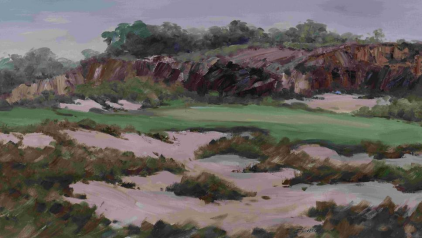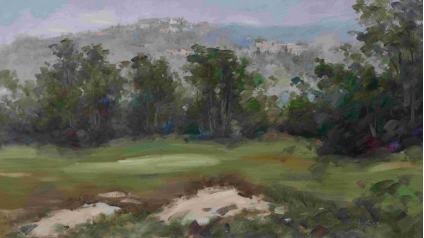
President of the Comité International d'Histoire de l'Art (CIHA)
Speech at the Opening Ceremony of Zhang Shaoxia's Solo Exhibition
Zhu Qingsheng
Professor at Peking University, President of the Comité International d'Histoire de l'Art (CIHA)
Zhu Qingsheng
Hello everyone! Nineteen years ago, in 2004, in Los Angeles, Mr. Zhang Shaoxia and I were preparing to return to China. I was a visiting scholar at Harvard while he was engaged in global activities. We accidentally met on our way back to China and decided to collaborate on the compilation of The Contemporary Chinese Art Yearbook. We decided to continue with the series since Zhang Shaoxia and Li Xiaoshan had previously written the History of Modern Chinese Painting, the first monograph on Chinese art history. Our paths diverged upon our return, with me returning to Peking University to continue my academic work while Zhang Shaoxia found himself in the distant land of Hainan.
There was a turning point when he told me after a time that "the most important thing now is the golf course." After arriving at the golf course, Zhang no longer had time to work on The Contemporary Chinese Art Yearbook but saw some things he had initially intended to do on golf courses. For him, with clever maneuvering, the subject of golf courses can lead to more significant developments, so he began to link golf courses with real estate.
After China's reform and opening up, two things are worth remembering. The first is the rise and rapid development of the Chinese economy, which has shaped China’s appearance today, as everyone knows. People may think of urbanization as a symbol of China's economic development, but another symbol is the construction of golf courses. I remember that the People's Bank of China had a graduate school in Beijing, where the first generation of financial researchers in China was educated, with Zhu Rongji as the nominal dean. Once, the school wanted to present a gift with symbolic significance to a scholar who was turning eighty, and after discussions, they decided to give the scholar a golf club. It can be told from this anecdote that, in their eyes, there is an ambiguous relationship between China's finances and golf. Now, we can find that golf courses are not accidental occurrences.
The second thing is contemporary art in China; the most noteworthy year for Chinese contemporary art is 1986. That year, Mr. Shui Tianzhong, Mr. Gao Minglu, and I gave presentations at a conference hosted by the Chinese Artists Association, each with our respective tasks. Mr. Shui Tianzhong presented A Century of Chinese Oil Painting, I spoke on the Expression and Introduction of Western Contemporary Art, and Mr. Gao Minglu discussed the 85 New Wave. Since then, Chinese contemporary art gradually moved towards a subtle, complex, fluctuating, and brilliant moment.
In 1986, the development of Chinese contemporary art was propelled forward, taking China's concern for society, efforts towards openness, and the possibility of more open-minded thinking as its driving force. Therefore, we began compiling the Chinese Modern Art Archive (CMAA), in which we mentioned the work done by Zhang Shaoxia and Li Xiaoshan in the southern region. At that point, we were eager to push Chinese art forward because we believed that China should take another step forward after global contemporary art had developed to its forefront. This step forward was necessary for China to go beyond being just an imitator. With this step taken, there would be more to China's reform and opening up than meets the eye; it would strive to lead the world toward opening up.
Figures like Joseph Beuys and Andy Warhol have surpassed the era of Duchamp, Picasso, Van Gogh, Gauguin, and Cézanne, making several rounds of progress. Yet, a new group of individuals emerged at the forefront—contemporary Chinese artists. Although we Chinese artists are poor or lack knowledge, we have sufficient spiritual strength and extraordinary efforts that keep us at the forefront of artistic exploration today.
Many artists born in the mid-1950s came of age during the reform and opening up. I have conducted extensive research worldwide and have been the chief editor of the Chinese Modern Art Archive (CMAA) since 1986, so I am well aware of the situation. The Chinese collective is not yet fully represented in terms of art as a whole. However, post-1950s Chinese artists carry weight and dominate the world with their abilities, accomplishments, and thoughts. It results from everyone's efforts and the outcome of China's reform and opening up. We must cherish it and develop it in the future.

A Green between Bunkers and Rocks (Qingyuan Lion Lake Country Club) 120×65cm Oil on Dew-retting Linen Canvas 2023
But what era has contemporary art come to today? It’s an era where new media and methods are used to advance new concepts. Times change, and we find ourselves again at the same starting point. We can see that much of today's art is created using new media. The emergence of new media art also brings tremendous pressure and fear. Artificial intelligence and machine-replicated materials and images cover much of our artistic practice, and human practices are often oppressed and replaced. Machines replace the commonalities and shared elements among people, but they suppress one crucial aspect: individual differences. These differences are the last seams and paths of human dignity when facing reality and the world. They cannot be stripped away; therefore, someone must display these differences.
And there came Zhang Shaoxia. While he walks on the golf course, swinging his club, he displays the brilliance that China once had and will have again. He understands that if we, as humans, want to maintain our dignity in the age of machines and post-humanism, we must use painting to explore the possibilities of art. Not all paintings can be done; we must gaze upon a familiar scene. When you pause and stare at it for over three seconds, then reflect on your inner memory and return to the painting, you can reveal your self-discoveries and see that there is still potential for exploration along this path. As contemporary art develops into new media art, we find that humanity is being divided and fragmented by new media art. It is crucial to assert, especially at critical moments, that today's humanity needs to maintain selfhood, dignity, individual differences, and the possibility of expression. Therefore, paintings like this exist. Such paintings may seem like a presentation by an explorer at a friend's gathering, but they harbor the opportunity for a turning point deep down. Hence, the significance of Zhang Shaoxia's exhibition is self-evident. Thank you!

Hidden Cities (Olympic Golf Course) 120×65cm Oil on Dew-retting Linen Canvas 2023
(Transcribed from speech recording)






